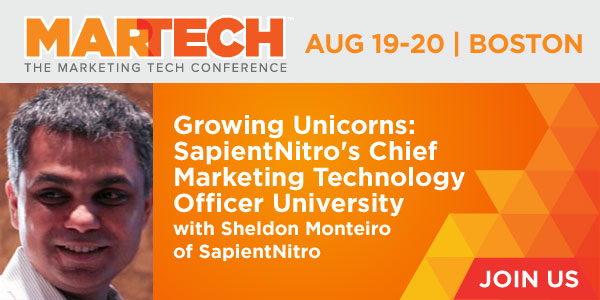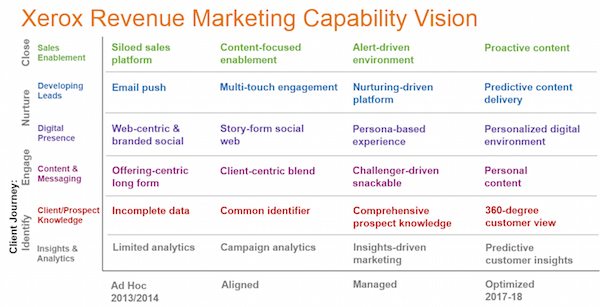Sheldon Monteiro, CTO of SapientNitro, is one of the sharpest people I have met in the marketing technology space. We were introduced by Mayur Gupta, the global head of marketing technology at Kimberly-Clark — and also a SapientNitro alum.
Taking Mayur and Sheldon as two points on a line, you have to extrapolate that SapientNitro is kind of “stellar nursery” for producing amazing marketing technologists.
Pretty much every conversation I’ve had with Sheldon has set my mind on fire. And the following Q&A with him is no exception. It started as a chance to discuss his upcoming keynote talk at MarTech this month, Growing Unicorns: SapientNitro’s Chief Marketing Technology Officer University — indeed, SapientNitro is quite deliberately birthing hybrid marketing technology stars.
But we expanded into a broad swath of strategic issues that every marketing leader can appreciate with technology management: opportunities in volatility, build vs. buy decisions, in-house vs. outsourcing decisions, the remaking of agencies, what’s missing from the marketing technology landscape, the collision of creativity and technology, and more.
Tell us a little about your background and your career path that led you to become the CTO of SapientNitro.
I had a nomadic childhood. Ours was a close-knit family, but my parents moved around a lot — I attended 6 different schools and 4 colleges. Sadly, I don’t have a single grade school friend I’m in touch with today. But for what I lost in roots, I gained in perspective: different cultures, types of people, value systems, and educational experiences. It had a huge impact on how I think, and on my attitude towards change. It doesn’t mean I like disruptive change more or less than anybody else, but I have the benefit of many years of learning to accept radical change as part of everyday life.
My first paid job was in marketing, at 14, conducting door-to-door market research surveys for consumer products. After 3 months, I figured that it would be much easier to make money in technology as an entrepreneur. I was obsessed with electronics as a teenager, and tapped that passion for commercial gain by assembling and repairing home computers. I suppose I was a maker long before making became the cultural phenomenon it is today. That hobby turned into a successful business that helped pay for college and a motorcycle, among other toys. What more could a teenager want?
Immediately after college, where I majored in physics and computer science, I found myself in Thailand, where a vacation turned into a two-year stint building systems for the financial industry — more specifically, graphical trading systems for brokers at the Stock Exchange of Thailand. Working with brokers was another phenomenal experience. These folks live on volatility. They don’t just accept it — more volatility literally means more opportunities to make money, and they need the information and technology to exploit that volatility. Little did I know, thriving in volatility would serve me well years later in marketing technology.
Working with brokers was another phenomenal experience. These folks live on volatility. They don’t just accept it — more volatility literally means more opportunities to make money.
Immediately after grad school, I was fortunate to have a number of job opportunities. One of those was with a fast growing technology services company in Boston, promising a focus on culture, teamwork, and cool technology to solve customer problems. On my first visit to their offices, I was blown away by the people, open spaces, and design centers where they conducted customer workshops. Two weeks later, I signed up with Sapient as an entry-level engineer as employee 196.
Sapient has changed a lot over the past 19 years. Today, we are over 12,000 people and well north of a billion in revenues. Here, I’ve had incredible opportunities to be an entrepreneur, to do amazing work, and to break new boundaries with innovative technology. Like my childhood, Sapient is close-knit, but we prosper on — and even instigate — change as a way of life.
I was elevated to the newly created role as SapientNitro’s Global CTO two years ago. We realized that though we were doing so much groundbreaking work with technology, we were often taking it for granted. I was running our Quality, Methodology and Tools efforts prior, in addition to client service, and this new role expanded my influence canvas significantly. Because it was a new role, I’ve been able to define it without a prior benchmark.
How would you describe SapientNitro? Are you a digital agency? Or something different?
The world has no shortage of advertising and communications as well as technology service firms. But much of the massive effort and expense in advertising and customer technology doesn’t translate to positive consumer experiences.
In today’s world, although consumers are in control, they have a fleeting attention span. Compound this with sensory and media overload. Brands have realized that consumers make no distinction between brand communications and experience. Brands are changing because consumers are. But are their agencies? I don’t know that the categories of digital agency or traditional agency are even relevant anymore.
What’s needed is a new breed of agency, architected for today’s consumer, that’s not in the business of creating ads or websites or apps, but rather envisioning and creating worlds that come alive through consumer touchpoints that attract, engage, transact, and retain. That make technology seamless, where the brand becomes part of the consumer’s life, not just a media impression or a channel of interaction.
We’ve built SapientNitro as that new breed of agency. We’ve assembled our talent, our culture, and how we work to value creativity and technology as equals — where technology instigates the creative process as much as it brings ideas to life.
We’ve assembled our talent, our culture, and how we work to value creativity and technology as equals — where technology instigates the creative process as much as it brings ideas to life.
I’m very proud that in 2013, we were acknowledged as OMMA’s Creative Agency of the Year and named a “Leader” in the Gartner Magic Quadrant for Global Digital Marketing Agencies published late last year. Receiving one recognition or the other is a major accomplishment — but only a new breed of agency is recognized for both. And, we also have maintained our strong heritage and recognition from Forrester as a leader in Experience Design and Technology services.
You’ve created a very unique executive development program at SapientNitro to “grow” hybrid marketing technology leaders, your Chief Marketing Technology Officer (CMTO) University. What led you to create this program? How does it work? Any successes so far?
As the world has shifted from analog to digital, from communications to experience, from story yelling to storyscaping, companies are left with a gaping hole: they need a new breed of technologist. They need someone who sees around corners and “gets” marketers and advertising. This new breed of technologist thinks at the intersection of marketing, technology, and story — and they aren’t afraid of charting new territory.
But technologists who understand the business of marketing — and can advise across the breadth of marketing technologies — are rare. It may seem strange to say this to you, given the stellar work and thought leadership you provide on the marketing technology space, but very few companies have taken the challenge to develop the talent capable of achieving success in this role. Many of our competitors have begun to talk about the intersection of marketing and technology, but few have made real strides to drive that convergence.
We created the CMTO University last year — an internal, yearlong leadership development program to grow some of our best technologists from across the globe.
To address this, we created the CMTO University last year — an internal, yearlong leadership development program to grow some of our best technologists from across the globe, focused on expanding their technology skills, equipping them with a mix of marketing fundamentals, and helping them increase influence through the power of persuasion and storytelling.
We combine theory with practice to ensure the class is applying what they learn, while they learn. We bring in diverse perspectives, from different disciplines — business strategy, brand strategy, creative design, analytics — leveraging famous talent from around our agency, our learning partners, and industry icons. Assignments include teaching others to master the material and “pay it forward.”
This program also imparts the tools to ensure the graduates continue to stay on top of what’s next — a critical skill in the digital world, as many marketing technologies become obsolete before many competitors even begin to master them. Our clients reap the benefits through the work we produce, and our participants see the impact of their collective transformation throughout the program, both in the curriculum and on project work.
In terms of success, our inaugural Class of 2014 just met in India for the final program intensive last weekend. It was an amazing, inspiring day, with an engaged audience, riveted to their seats from start to the finish. They presented the culmination of their work in the program to over 300 attendees in Bangalore, including their peers and our community of technologists, at WHAT’S NEXT IS NOW, a full-day conference event. Using the storytelling skills learned in the curriculum, the students discussed how brands can build and maintain strong connections with customers by breaking boundaries at the intersection of technology and story.
Our CMTO University program resulted in changes big and small — from helping imagine new possibilities during our ideation and pitch process, to changing the narrative during our project acceptance phases.
Our students are already making a very different kind of impact in their work with our clients. It’s resulted in changes big and small — from helping imagine new possibilities during our ideation and pitch process, to changing the narrative during our project acceptance phases. Perhaps the biggest change for our participants is the change they report in perspective. They report they are more fearless and unconstrained in how they think about the future, and most importantly, their role and responsibility in creating and shaping it.
From your perspective, what’s happening in the broader agency world? To me, it often seems that agencies are somewhere between a state of massive disruption (“advertising is dead!”) and total denial (“long live the 30-second spot, where the media dollars still flow like water”). What’s your take? What’s the future look like?
For over two centuries, agencies made their bread and butter through media commissions. Media formats have evolved, but the reality is that the business model of most agencies is still heavily dependent on those commissions. If you are in one of those agencies, you are going to try very hard to maintain that equilibrium and to force fit the new networked economy into the old broadcast paradigm.
The business model of most agencies is still heavily dependent on media commissions. They try very hard to force fit the new networked economy into the old broadcast paradigm.
We’re trending towards addressability and interaction across every channel, including television, out-of-home, and even physical computing in immersive spaces. With that comes the opportunity for brands to target and provide contextual relevance in every interaction and with every communication, no matter where the consumer is. This presents a massive opportunity for agencies that can get comfortable with accountability for every dollar spent — whether that money is spent on communications or experience.
We believe that connected “omnichannel” experiences are more than just responsive versions of websites, but are actual immersive media spaces and canvases that transcend devices and advertising. We are able to engage the consumer via emotional connections, physical connections, as well as virtual connections, in a continuous story that increases brand engagement.
How do you look at the landscape of a thousand marketing technology vendors? Are they your raw materials? Your partners? Your competitors? It seems increasingly complicated as technology vendors — for instance, IBM — are also selling services and agency-like offerings to CMOs.
There is no shortage of choice when it comes to marketing technology. But as exciting as marketing and marketing technology is, I want to underscore the potential to use all of this fantastic technology to innovate the business. Peter Drucker famously said, “Because the purpose of business is to create a customer, the business enterprise has two — and only two — basic functions: marketing and innovation. Marketing and innovation produce results; all the rest are costs.”
If you are, say, the CEO of a taxi company, you could apply a great amount of marketing technology to better connect with your customers, and you would still be disrupted by Uber. Uber fundamentally re-imagined the taxi and limousine business by creating a service for the networked world we live in — and there is no arguing that their business is powered by software, the cloud, and mobility.
If you are the CEO of a taxi company, you could apply a great amount of marketing technology to better connect with your customers, and you would still be disrupted by Uber.
Against this backdrop, the question for us as marketers is: do we do old things with the new tools, or fundamentally disrupt ourselves — creating new value, in new ways, with the new tools we have at our disposal? The answer to me seems obvious. The latter can yield step change, while the former yields incremental change. We need to do both. This is where the galactic choices we have with marketing technology can be a benefit or a distraction.
Technology can fuel innovation and re-imagine business — Uber would not have been practical a decade ago because the technology and deployed mobile infrastructure simply did not exist. Yet all that choice can be a huge distraction — I’ve seen large organizations make multiple competing investments in the same functional categories. That’s not just waste. It fragments the customer experience.
We help our clients create experiences and tell their stories by marrying imagination with systems thinking. Brands can move beyond making ads and into creating worlds where their story becomes part of the consumer’s story. This new reality requires that legacy agency, business, and marketing paradigms be eliminated. The silos that divide creativity and technology — and any lines between the physical and virtual — no longer exist in the real world, and they don’t exist in ours.
We help our clients create experiences and tell their stories by marrying imagination with systems thinking.
How do you manage the complexity of a 1,000+ vendors? Old notions of enterprise architecture and standards governance often break down at the velocity with which marketing technology is advancing. It’s often seen as an impediment to progress. At the same time, without conscious choice, you have duplication, or the specter of a thousand flowers blooming.
With systems thinking, we take a disciplined approach to applying the right mix of speculative and proven technology to support the brand-consumer story. We combine hacking and engineering skillsets with the methodology and culture to support that marriage. We continue to invest in new capability building and keep a pulse on emerging technologies, platforms, and development techniques around industry verticals. We incubate new talent to ensure we don’t stagnate, as many agencies and integrators often do when they scale.
The space we are in is hotly contested by agencies, systems integrators, and even product vendors. Product companies, in an attempt to protect their software and hardware revenues, are offering agency services. Agencies, in an attempt to protect their media business, are offering systems integration. And systems integrators are moving into the interactive space.
In reality, it’s incredibly difficult to create a company that values creativity as much as it values technology. How do you systematically foster and celebrate “weird” in a product or systems integration business? How do you value process and scale in a creative culture? These are basic questions, but they are fundamental to delivering value with the problems our clients bring us.
It’s incredibly difficult to create a company that values creativity as much as it values technology. How do you systematically foster and celebrate “weird” in a product or systems integration business? How do you value process and scale in a creative culture?
Finally, you observed — and I agree — that there is no shortage of choice in marketing technology. Yet there remain vast swaths of marketing and experience problems that have immature solutions. For instance, the digitization of physical spaces and commerce logistics and fulfillment are still at very early stages. There are very bright minds working on these problems, and we are constantly on “hunts” to explore these areas in response to customer needs or known whitespace.
Drafting on that, how do you make the decision for what to build with your team or buy from a vendor? Are there certain kinds of capabilities — perhaps particular layers of marketing technology — that you think are better built custom for brands?
There is no silver bullet answer to this question. Innovation and marketing inherently thrive on disruption, so that would appear to be a good argument for choosing niche vendors or building custom, differentiated solutions. At the same time, you would be hard-pressed to build from scratch when there are proven solutions that solve for known problem sets, like web content management or digital commerce. Open source options are now available in most every space from core infrastructure to experience management.
How do you make choices?
The moment you decide to build custom software — and that software is directly impacting your customer’s experience — you are now a software company.
The first thing to note is that the moment you decide to build custom software — and that software is directly impacting your customer’s experience — you are now a software company. With internal applications, you can defer enhancements and upgrades by process or training interventions. Unless you are a monopoly, or your customers are willing to accept a poorer experience because you offer lower pricing, for example, you can’t do that with software that your customers experience directly.
Packaged software somewhat mitigates this problem by shifting the onus of enhancements to the vendor. Yet, if your customer experience demands change at a rate faster than your vendor can deliver, you face the specter of having to build enhancements yourself — or switch vendors.
All this said, a brand would be hard-pressed to justify building core infrastructure technologies, middleware, or databases. There are just too many great options to not choose from one of the commercial or open source options. The answer as you move up the stack is nuanced — and sits at the intersection or function, form, differentiation and cost.
If you are a small or midsize business, chances are you don’t want to be a software company, and you should seek to use off-the-shelf software to the extent you can, building differentiation with how you use the tools, rather than re-inventing the tools themselves. On the other hand, if your competition is outsmarting you with software, you would be ill-advised to sit still while waiting for your vendor ecosystem to catch up and provide you with the weapons to compete.
If your competition is outsmarting you with software, you would be ill-advised to sit still while waiting for your vendor ecosystem to catch up.
At the other end of the spectrum lies experience technology — the mobile, web, responsive and in-venue applications that your customers actually experience as your brand presence. I’d be reluctant to have this layer look at all similar to my competitors, and this would be one area where custom builds can be more the norm than the exception.
What marketing technology capabilities — both technical infrastructure and human resources — should a brand have in-house? What should they turn to agencies like yours to provide? Obviously, you’re biased here, and it probably varies a lot from company to company, but how would you frame those choices?
As you observed, the answer varies. IT departments have been moving up the outsourcing continuum for decades. They have been doing so for a variety of reasons — specialized expertise, temporary or project specific needs, and economies of scale, to name a few. On the other hand, companies hired agencies because the agency is independent and provided an outside point-of-view to the effort of selling the company’s products or services.
The truth is, for the foreseeable future, the sheer amount of innovation in the marketing technology space will create more opportunity — and hence more work — than can be delivered by the available talent, in-house or at agencies.
With marketing and marketing technology outsourcing, you need to do some introspection and honestly answer some basic questions, such as:
- Do I have, or can I create the culture to bring together creativity and technology within my organization?
- Do I have the talent and capabilities to be a software or product company? Do I believe I can retain this talent and sustain these capabilities in the future?
- Do I need the expertise and efficiency that a medium or large agency brings? If yes, how can I access that?
- Are my internal users happy with my in-house technology capabilities? If yes, will these scale to meet the increased demands of external customers? If not, why do I believe that my external, non-captive users will be well served with these capabilities?
- Given the rate of change in marketing technology, am I prepared to make the commitment to up-skill and transform my workforce with each new wave of technology? Even if this requires changing staff?
- Can I disrupt myself, or will a third party help me imagine my obituary and avoid that fate?
One additional point — the decision to outsource must go hand-in-hand with the incentives and tooling to integrate the provider’s teams deeply with your in-house business, development, and operations teams. The traditional model of outsourcing discrete projects and throwing deliverables over the wall is a recipe for suboptimal results and barely meeting consumer desires.
The decision to outsource must go hand-in-hand with the incentives and tooling to integrate the provider’s teams deeply with your in-house teams.
Old-style procurement models for both systems integration and agency services are under pressure, as they often put the client’s and service provider’s interests at odds — and often don’t value enough the potential for innovating and driving massive disruption in the competitive space or consumer engagement with the brand. There is much work to be done in this area. I’ve seen tremendous success with shared incentives that are focused on the greatness of work.
Wow, Sheldon — this was terrific. Thank you!





Hi Scott, this article was all together different from the previous ones. Really enjoyed it a lot! Understanding things from a different perspective. I have heard Sheldon previously at some events and always enjoyed his perspectives and especially as it comes from agency side.
The last point around having incentive for provider to deeply integrate with your teams is so important, not just in marketing technology but in all fields of outsourcing. The only way to set any agency for success is by thinking a win-win relation.
Wow – there is so much gold in this interview I don’t even know where to start! Thanks for sharing!
A great read and so bang on in many of the issues we face in large corporate. The challenges in determining the pros and cons of decisions that we make in this warp speed space are formidable but clearly there are people doing some great thinking around this.
The second half of the is article was interesting, particularly the discussion of whether or not businesses should develop their marketing technology tools or use an “off the shelf solution.” However, when I read passages like the following, my eyes just glaze over:
“What’s needed is a new breed of agency, architected for today’s consumer, that’s not in the business of creating ads or websites or apps, but rather envisioning and creating worlds that come alive through consumer touchpoints that attract, engage, transact, and retain. That make technology seamless, where the brand becomes part of the consumer’s life, not just a media impression or a channel of interaction.”
“We believe that connected “omnichannel” experiences are more than just responsive versions of websites, but are actual immersive media spaces and canvases that transcend devices and advertising. We are able to engage the consumer via emotional connections, physical connections, as well as virtual connections, in a continuous story that increases brand engagement.”
These are not substantive remarks. Agency people (and business consultants in general) are notorious offenders with respect to communicating via jargon and platitudes. They say a lot without really saying anything. I suspect this is because none of them really have particularly strong competitive advantages. The landscape is monopolistically competitive and arguably becoming more perfectly competitive as a result of the globalization of marketing services and the ease with which technology allows digital marketing to be done effectively in-house without paying agency fees. The result is you have agencies trying to sell themselves as “creating worlds that come alive through consumer touchpoints” instead of creating websites, apps, and ads and targeting them at relevant people based on facts, data, and other forms of evidence.